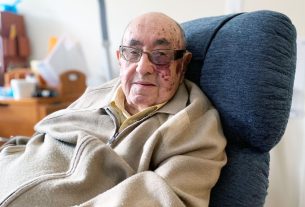A prominent childhood memory is of my grandparents living with and then dying from dementia. As is universal with dementia, there was a double blow: watching my grandparents lose their identity and seeing the suffering of those closest to them.
As a junior doctor on a specialist dementia ward when I was in my 20s, I watched the same stories play out for family after family, feeling largely powerless to help. Now in my 30s, I conduct public health research to understand what we can do to prevent, delay or improve the experience of dementia – the leading cause of death in England.
Naturally, this makes me desperate for good news on treatment options for Alzheimer’s disease – the main cause of dementia. Enter three drugs (aducanumab (trade name Aduhelm), lecanemab (Leqembi) and donanemab) that remove amyloid, the protein thought to cause Alzheimer’s disease. Unlike their many predecessors, that also successfully removed amyloid from the brain, these drugs were the first to slow cognitive decline.
This breakthrough was hailed as “the beginning of the end for Alzheimer’s disease”, but how useful are these drugs going to be? There are four key shortcomings to consider:
1. Tiny benefits: In the donanemab trial, the people taking the drug declined on average by ten points on a 144-point cognitive scale. The placebo group declined by 13 points.
Consistent with the patterns in the trials of the other two drugs, this tells us that all groups in all these trials declined and the amount of decline that was avoided by taking the drug – in this case donanemab – (three points) was a lot smaller than the amount of decline that still occurred (ten points). The difference in the amount of decline was so small that it would probably not be noticeable to the doctors looking after these patients.
2. Side-effects: Through regular magnetic resonance imaging (MRI) scans, one in six people taking lecanemab was found to have evidence of brain bleeding, and one in eight had brain swelling.
Regular scans will sometimes pick up these pathologies in dementia patients. And, indeed, one in 11 of those in the placebo group had evidence of bleeding, while one in 59 had swelling. For most people, these events were only detectable by MRI and not through showing any specific symptoms. However, the effects of this drug’s damage to the brain, particularly the long-term effects, are unknown.
Sadly, there have also been a few deaths attributed to these drugs.
3. Very expensive: Aducanumab was marketed in the US for US$45,000 (£35,000) per patient per year (later reduced to US$20,000 to increase demand), and lecanemab for US$26,500. This is just for the drug itself. Health systems also need to pay for additional scans to test for eligibility, monitoring and management of side-effects, and staff to run infusion clinics.
The donanemab trial suggested that treatment could end when brain scans showed sufficient amyloid clearance. But we don’t know if amyloid will return after some time. Regular monitoring for amyloid recurrence and repeated bouts of treatment would add further costs.
There are other impositions for patients: attending centres every two to four weeks for drug infusions and regular monitoring and worrying about side-effects.
Dragon Images/Shutterstock
4. Highly selective trials: It is accepted that not all trial “efficacy” (the effect seen in a specialised trial context, designed to maximise the likelihood of treatments working, such as including only uncomplicated cases) will convert into clinical “effectiveness” (the effect seen when drugs are given to relatively more complex patients in busy, real-world clinical settings). This is concerning, because there’s little wriggle room before the effects become undetectable. And, while this is the case for all diseases, Alzheimer’s is likely to be an extreme example.
For every ten patients that doctors thought might be eligible for these trials, seven or eight were rejected. People with brain pathologies other than amyloid, such as vascular damage or Lewy bodies, and those with significant other medical problems, which might have clouded the trial results and increased the risk of side-effects, were excluded.
If the drug eligibility is restricted to match the trial eligibility, then very few people will be eligible. If eligibility is broader, then already small effects are likely to be even smaller and side-effects more pronounced.
Profound shortcomings
There’s more. The trials selected people at the earliest stages of the disease – that is, when symptoms had only recently developed – and successfully cleared amyloid, yet patients still declined almost as fast. So inevitably, researchers ask: maybe we need to start the drugs even earlier? But how?
People in the trials were, on average, five to ten years younger than most people are at Alzheimer’s diagnosis in the US and UK. And catching people earlier in the disease is problematic because most people with amyloid but no cognitive symptoms won’t get dementia before they die.
Sadly, I don’t think these drugs can make a big difference for people currently, or soon to be, living with Alzheimer’s disease. Also, the shortcomings are so profound, despite decades of expensive trials and patient sacrifice, I think it’s time to take the amyloid blinkers off and prioritise exploring other, neglected, options for treating dementia.
This isn’t the beginning of the end of Alzheimer’s, but perhaps it should be the end of the anti-amyloid drug pathway.



